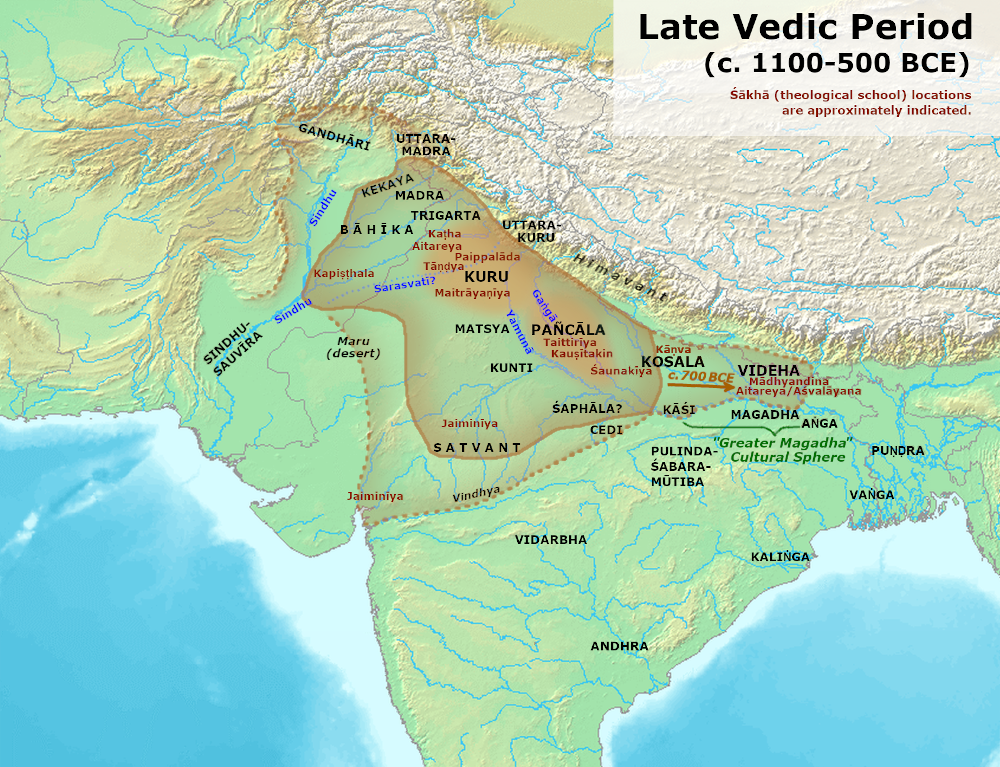Sage Kasyapa Heads to Hastinapur to Save Parikshit From Takshaka

Table of Contents (The Complete Mahabharata in Simple English)
Previous Post: King Parikshit’s Response to Sage Samika’s Message
| Note: In the previous post, we read about how King Parikshit (after being forewarned by Sage Samika), had a mansion built on a single column and took various measures to protect himself from Takshaka. In this post, we will read about the incident where Sage Kasyapa, who could revive people suffering from snake bites, decided to hasten to Hastinapur to save thecking in case he was attacked by Takshaka. |
On the seventh and final day of Sringin’s curse to King Parikshit, Sage Kasyapa, who had also heard about the curse, set forth to Hastinapur to save Parikshit in case Takshaka bit the monarch. The sage knew mantras and other techniques of reviving any life-form bitten by a snake. As he walked towards Hastinapur, Kasyapa thought of the virtue and wealth he would gather by curing the king.
However, the deadly snake, Takshaka, saw Kasyapa walking rapidly towards Hastinapur. He immediately took the guise of an old Brahmin and intercepted Sage Kasyapa.
“Where are you going in such haste, O great sage, and for what reason?” The disguised Takshaka asked Kasyapa.
“I have heard that Takshaka is going to inflict death on Parikshit, the powerful king of the Kuru race, by his poison. I’m going to Hastinapur to save the king,” Kasyapa answered.
“I am Takshaka, O Brahmana, and I’m going to burn that king with my poison. It is impossible for you to cure someone who has been affected by my poison,” Takshaka said.
Kasyapa replied, “I’m sure I’ll be able to cure the king with my knowledge of mantras and healing.”
“O Kasyapa, if that is true then try and revive that tree which I’m soon going to burn down with my poison,” Takshaka challenged the sage.
“O king of snakes, do so if you will. I will revive the tree,” Sage Kasyapa answered.
Takshaka went to a nearby banyan tree and bit it, injecting his deadly poison in the tree. At that very moment, the tree started blazing all around.
After burning down the tree, Takshaka said, “O sage, try and revive this tree.”
The banyan tree (also referred in the Mahabharata as the king of the forest), was reduced to ashes by then. Sage Kasyapa took the ashes in his hands and said to Takshaka, “O king of snakes, now witness the power of my knowledge as I revive the tree from these ashes.”
Kasyapa piled the remains of the tree and used his knowledge (most likely of mantras) to make a sprout to grow in that mound of ashes. Then he caused the sprout to grow until there was a stem. Soon after that, branches appeared. Within some time, the revived tree that had started as a sprout was once again a full-fledged tree.
When Takshaka saw the tree fully revived, he said, “O sage, you have revived the tree, but it is not an admirable act for someone whose wealth is asceticism. What reward do you seek by curing the monarch? I will give you the same reward the king would have given you.”
Takshaka continued, “O sage, you are very famous. Think about what you are going to attempt. The king has been cursed by a brahmin whose words carry immense power. This curse has certainly reduced the lifespan of the king. Therefore, even though you revived the tree, you may not be able to revive the king, and this failure will wipe out all the glory and fame you have accumulated till now.”
Kasyapa heard Takshaka’s words and said, “I’m going to Hastinapur for wealth. Give me the gold I would have received there, and I will return to my home.”
Takshaka said, “O best of sages, I will give you more wealth than you would have received in Hastinapur. Therefore, do not proceed in that direction.”
Hearing Takshaka’s words, that great sage, Kasyapa, sat down on the ground and entered a state of meditation. He meditated over the king, and, through his spiritual sight, saw that the king’s lifespan was indeed about to end and there was no way to save him.
After coming out of the meditative state, sage Kasyapa turned away from Hastinapur, and Takshaka went towards Hastinapur.
| Note: This incident is very interesting because it is full of contradictions. 1. It shows a noble sage like Kasyapa hastening to Hastinapur to cure the king only for the sake of money. 2. Kasyapa was a sage who could clearly discern the past, present, and future of anything or anyone, yet, he is so easily deceived by Takshaka. 3. Kasyapa sits in meditation to ascertain Parikshit’s future only at the end of this incident, and not at the beginning before he left his home to proceed to Hastinapur. All these seem to be strange for a wise sage. These contradictions remind me of what a very learned and wise person had said: “First sit at the feet of these great epics and learn from them before finding mistakes in them.” I wholeheartedly agree with the above statement. I believe that the Mahabharata is a multi-layered story, and such an obvious contradiction is an invitation (a marker) to the discerning reader to introspect beyond the obvious. I think it will be a good exercise to think about what really happened in this scene and why it happened. In the next post, we will see Takshaka at his deceptive best, once he reaches Hastinapur. |
Table of Contents (The Complete Mahabharata in Simple English)
Next Post: Takshaka Goes to Hastinapur
